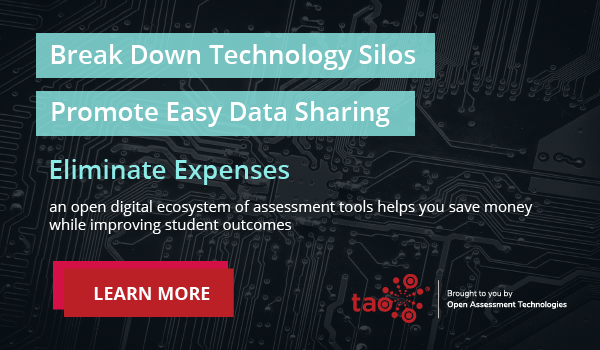Assessments are an important part of the learning process. All assessments, including formative, interim, and summative assessments provide educators with data on what students know and where to go next. In recent years, schools have been shifting away from traditional summative assessments and moving towards formative assessments to guide teaching and learning. While summative assessments may do a good job of letting educators know where students end up, they do not provide timely data that can be used to further student growth. Formative assessments, with their quick turnaround time and adaptive nature, allow teachers to quickly see what students know and whether a particular lesson has been effective or not.
One of the big reasons for the shift towards formative assessment has to do with technology. Online testing and learning platforms give teachers the ability to give formative assessments and analyze large data sets quickly. Instead of spending time managing data, technology gives teachers the freedom to use data to inform instruction.
The Value of Formative Assessment
Formative assessment holds significant value in education, as it is a powerful tool for enhancing the teaching and learning process. With formative assessment, there is a continuous feedback loop between educators and students, enabling them to monitor progress and make necessary adjustments in real time. Teachers can identify areas where students may be struggling and adapt their instructional strategies accordingly. Students, in turn, receive immediate feedback on their performance, allowing them to take ownership of their learning and make improvements. This ongoing feedback supports the growth and development of students’ knowledge and skills.
Ongoing formative assessment also helps tailor instruction to meet individual student needs. By recognizing where each student stands in their learning journey, teachers can personalize their approach, providing additional support or challenges as needed. This differentiation acknowledges that every student has a unique learning pace and style, ultimately leading to more effective learning outcomes.
The value of formative assessment may also lie in the collected data. This data can inform instructional decisions at the classroom, school, and district levels. Teachers can identify patterns and trends in student performance and use this data to inform curriculum adjustments, resource allocation, and professional development needs. At the institutional level, formative assessment data can contribute to evidence-based decision-making, helping educators and administrators enhance educational practices and policies.
Why are educators incorporating more formative assessments using technology?
The incorporation of more formative assessment tools in education is driven by the desire to enhance teaching and learning, improve student outcomes, and create a more flexible and personalized educational experience. It aligns with the evolving needs of students and the goal of creating a more effective and engaging learning environment.
Adding in technology, formative assessments become even more powerful for both students and teachers. Technology frees up time and can help teachers manage larger data sets more efficiently so that they can see the big picture and make changes as needed. This gives educators a better view of students’ capabilities, creates a closer tie to the curriculum, increases engagement, and allows for quick adjustments to instruction.
Shows a better picture of student capabilities
Unlike traditional summative assessments, formative assessments are ongoing and involve multiple learning opportunities. Formative assessments may happen more frequently which gives educators and students a clear picture of where a student started and where they ended. This information can then be used by educators to plan future lessons and to determine next steps.
Formative assessments also allow educators to make targeted feedback in the moment, rather than waiting until the end of a unit. Due to their shortened and specific nature, formative assessments can be collected quickly and feedback can be delivered in the moment, giving a day-by-day view of student growth.
Creates a closer tie to the curriculum
Formative assessment creates a closer tie to the curriculum by serving as an integral component of the instructional process. As teachers build lessons with formative assessments embedded it may foster a closer tie with curriculum throughout a lesson and unit. Technology can assist educators in developing formative assessments that are closely tied to the curriculum. Here are ways in which technology can connect formative assessment to curriculum:
- Alignment with Learning Objectives: Formative assessments are designed to align closely with the learning objectives and content of the curriculum. Technology can be used to link and track formative assessment data to standards.
- Ongoing Feedback Loop: Technology can provide a real-time feedback loop between assessment and instruction that ensures that curriculum pacing and content are responsive to students’ needs.
- Curriculum Adaptation: If assessments reveal that students are struggling with a particular concept or skill, educators can modify the curriculum using technology to provide additional instruction, resources, or alternative approaches to address those challenges.
- Individualized Learning Paths: Technology can provide flexible learning paths and may help educators identify individual student strengths and weaknesses allowing them to create personalized learning paths that align with the broader curriculum
- Curriculum Differentiation: Using technology, educators can use formative assessment data to differentiate instruction within the classroom.
Increases engagement and personalization
Incorporating technology into formative assessment can increase engagement and personalization in learning, through interactive platforms like TAO testing, and tools, such as online quizzes, gamified assessments, and educational apps, that are more engaging and enjoyable for students. These platforms can incorporate multimedia elements, immediate feedback, and interactive features that make the assessment experience more interactive and enjoyable, boosting student engagement.
Students also receive instant feedback on their performance when using a tech-based formative assessment, allowing them to self-assess and make corrections in real time. This quick feedback loop keeps students engaged and motivated as they see their progress and areas for improvement.
Allows for quick adjustment and correction
Adjusting and correcting misconceptions quickly is an important part of the teaching and learning cycle. When students can get misconceptions corrected on time it allows them to move forward with the right information rather than fossilizing incorrect thinking. Technology in formative assessment allows for quick adjustment and correction in several ways:
- Real-Time Feedback: Technology enables immediate feedback to both students and educators. As students complete formative assessments, they receive instant feedback on their performance. This quick feedback loop allows students to identify and correct misconceptions or errors in real-time. It promotes a deeper understanding of the material and helps prevent the reinforcement of incorrect information.
- Data Analysis: Technology provides tools for rapid data analysis. Assessment results are automatically compiled and analyzed, allowing educators to quickly identify trends and patterns in student performance. Educators can pinpoint areas where students are struggling and make timely adjustments to their instructional strategies. For example, students in France were asked to give the area of a lake, and data from the TAO platform showed that students mixed up area and circumference. This enabled educators to make on-the-fly changes and provide targeted learning.
- Adaptive Assessments: Some technology-based formative assessment platforms offer adaptive assessments. These assessments adjust the level of difficulty and content based on individual student performance. If a student is consistently answering questions correctly, the assessment may progress to more challenging material. Conversely, if a student is struggling, the assessment can offer additional practice and support, ensuring that each student receives an appropriate level of challenge and instruction.
- Personalized Recommendations: Technology can provide personalized recommendations for students based on their performance. If a student is consistently scoring well on a particular topic, the technology may suggest moving on to more advanced content. Conversely, if a student is struggling, the technology can recommend additional resources or practice exercises to address specific weaknesses.
—
Formative assessment is quickly becoming a cornerstone of testing and measuring student growth and achievement. Through formative assessment, students can show what they know with a quick turnaround time for feedback. This responsiveness enables educators to continually meet students where they are and design a curriculum to push students individually.
Implementing technology into formative assessment tools can improve the efficiency and accuracy of formative assessment. Through platforms like TAO, educators can design assessments using adaptive testing technology, large data-analysis tools, and artificial intelligence that provide students with a unique and personalized learning experience. All of this serves to enhance student learning and growth over a school year.


